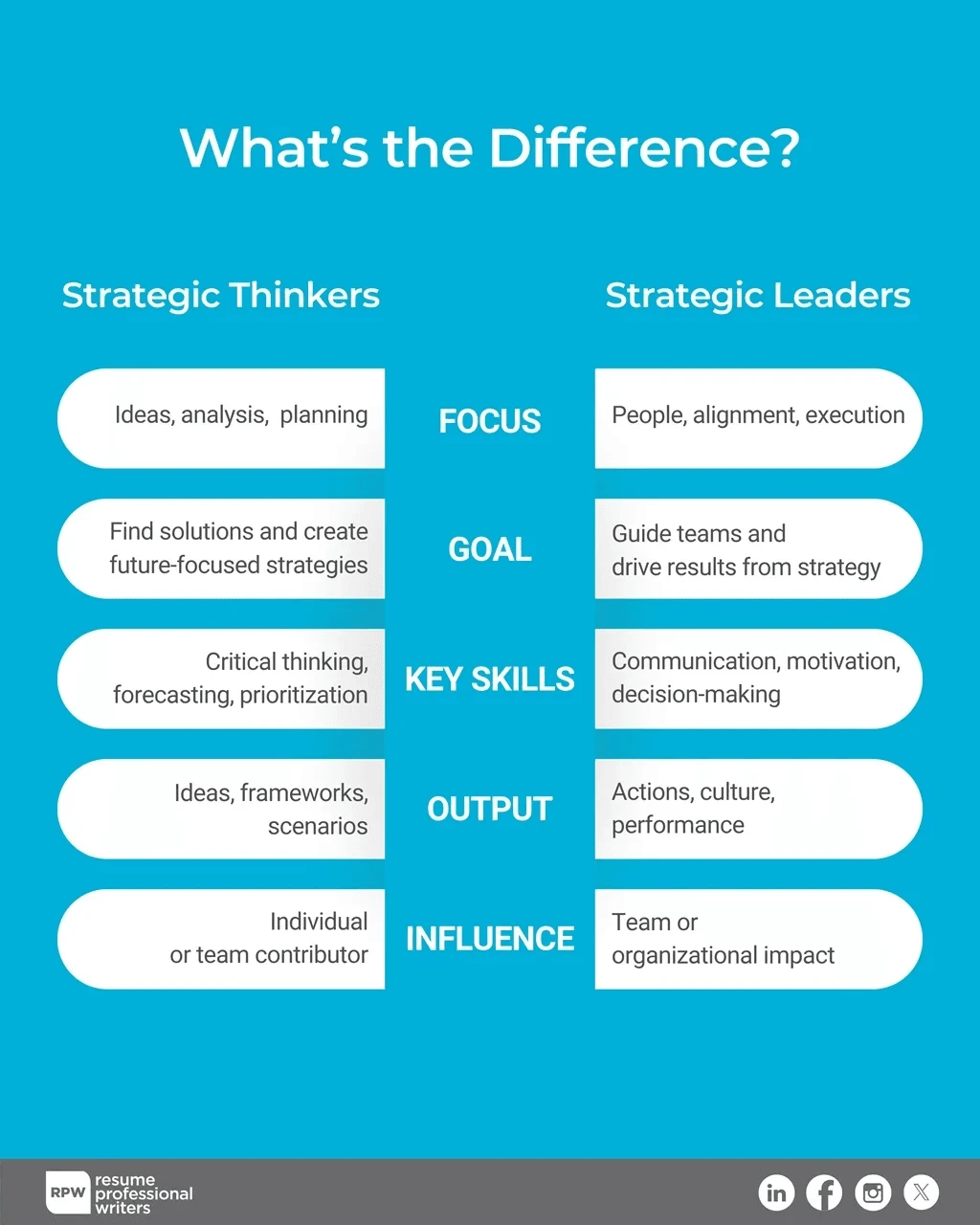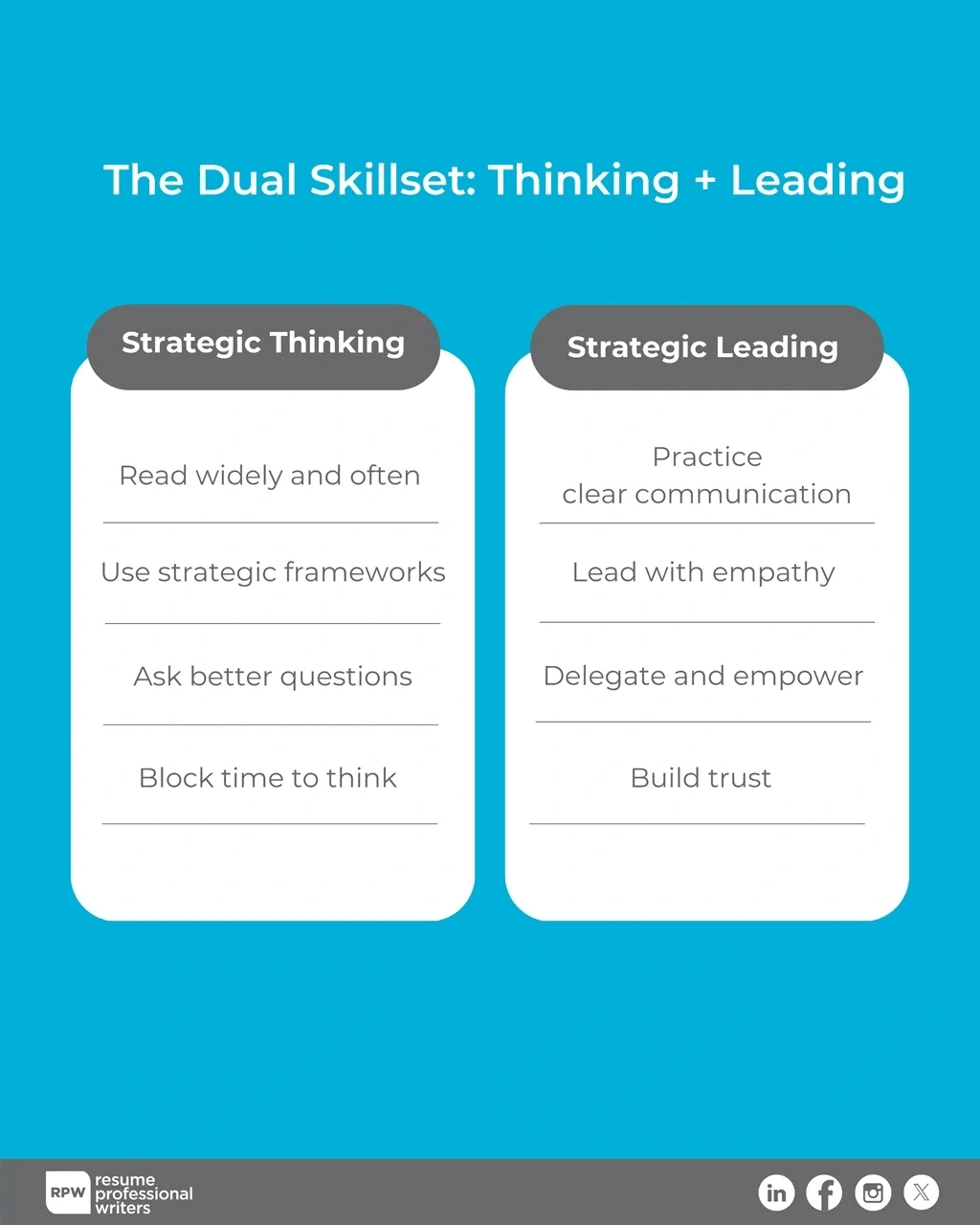Strategic thinking vs strategic leadership—what’s the real difference, and why does it matter to your career? While both are essential for long-term success, they serve different yet complementary purposes. Strategic thinking helps you analyze complex situations, foresee challenges, and make informed decisions. Strategic leadership, on the other hand, empowers you to influence others, communicate vision, and drive execution. Whether you’re advancing in your role or guiding an entire organization, understanding these two concepts will give you the clarity and capability to lead with confidence and intention.
Whether you’re mapping out your next big career move or guiding an entire organization, knowing the difference between strategic thinking vs. strategic leadership gives you the clarity and edge to act with purpose and influence.
In this comprehensive guide, we’ll define each concept, explore their key differences, highlight how they work together, and show you how to master both skills for maximum career and business impact.

Defining Strategic Thinking
Strategic thinking is the ability to analyze situations, recognize patterns, and consider long-term outcomes to make smart, forward-looking decisions. It’s not about reacting to what’s in front of you—it’s about anticipating what’s ahead and planning accordingly.
Key Traits of Strategic Thinkers:
Strategic thinking helps uncover opportunities, anticipate challenges, and create meaningful impact beyond daily tasks. By thinking strategically, individuals become more valuable, adaptable, and prepared to lead through change.
Here are the key traits that define a strategic thinker:
- Analytical and curious
- Able to see the big picture
- Forward-looking and proactive
- Pattern and trend-aware
- Comfortable with ambiguity
Strategic thinking isn’t limited to executives. Anyone—whether an intern or CEO—can develop this mindset by stepping back from the day-to-day and asking questions like:
- “Where are we going?”
- “What’s changing in our environment?”
- “How will today’s decisions affect the future?”
In short, strategic thinkers are visionaries and problem solvers. They don’t just work in the business—they think on the business.
Defining Strategic Leadership
Strategic leadership involves using influence, communication, and vision to guide people and organizations toward long-term goals. It’s about executing strategy through others while aligning teams and resources toward shared objectives.
Key Traits of Strategic Leaders:
- Visionary and goal-driven
- Inspiring and communicative
- Results-oriented but people-focused
- Able to manage risk, uncertainty, and change
- Skilled at empowering others to act
A strategic leader is someone who not only sees the path forward—but has the ability to rally others behind it. Think of them as the bridge between strategy and execution, direction and action.
Strategic Thinking vs Strategic Leadership: Key Differences
Let’s break down the major distinctions between the two.

While strategic thinking is a cognitive process, strategic leadership is a behavioral process that requires influencing others.
How They Complement Each Other
The best leaders are strategic thinkers—and the best strategic thinkers eventually become leaders.
Think of strategic thinking as the engine and strategic leadership as the driver. One produces momentum and vision; the other steers it in the right direction.
Here’s how they complement each other:
- Strategic thinkers generate ideas. Strategic leaders filter and prioritize those ideas into executable plans.
- Strategic thinkers identify opportunities. Strategic leaders mobilize teams to seize those opportunities.
- Strategic thinkers see the map. Strategic leaders take the wheel and lead others through the journey.
You can be a great thinker and a poor leader—or vice versa. But developing both makes you a rare and powerful force in any organization.
Examples in Real-World Settings
From solving business challenges to navigating career growth, strategic thinkers apply foresight, planning, and adaptability to drive better outcomes. The following examples illustrate how this mindset plays out across different real-world settings:
Example 1: In Business Strategy
- A strategic thinker notices declining customer retention and hypothesizes that outdated onboarding is the issue.
- A strategic leader redesigns the onboarding experience, trains the customer support team, and leads the rollout company-wide.
Example 2: In Project Management
- A strategic thinker anticipates resource conflicts across multiple teams three months ahead.
- A strategic leader adjusts the roadmap, communicates expectations, and ensures alignment with senior stakeholders.
Example 3: In Career Planning
- A strategic thinker maps out their career goals and skills needed for a leadership role.
- A strategic leader mentors others, builds influence, and secures buy-in for cross-functional projects to step into a new role.
In each case, both thinking and leadership are necessary for meaningful, lasting results.
Why Understanding the Difference Matters
Understanding the difference between strategic thinking and strategic leadership helps you:
1. Identify Strengths and Gaps
You might be a brilliant thinker but struggle to lead. Or you may lead well but lack long-term clarity. Knowing where you stand allows targeted development.
2. Elevate Your Career
Hiring managers and executives value people who don’t just do the work, but drive the business. Combining strategy and leadership puts you on the radar for promotions.
3. Create Greater Impact
When you combine high-level thinking with effective leadership, you influence more than just outcomes—you shape culture, innovation, and future direction.
How to Develop Both Strategic Thinking and Strategic Leadership
While strategic thinking sharpens your ability to see patterns, anticipate change, and make smarter decisions, strategic leadership brings those insights to life through action, influence, and alignment. Building both requires intention, self-awareness, and practice.
Here’s how to start developing each skill:
Develop Strategic Thinking:
- Read widely and often. Expose yourself to industry reports, case studies, and thought leaders.
- Use strategic frameworks. Try tools like SWOT, PESTLE, or Porter’s Five Forces to organize your thinking.
- Ask better questions. “What are we missing?”, “What happens if we fail?”, “What does the future require?”
- Block time to think. Leaders often lack time for deep thought. Prioritize reflection in your schedule.
Develop Strategic Leadership:
- Practice clear communication. Articulate vision, goals, and the “why” behind decisions.
- Lead with empathy. Strategic leaders care about people and results equally.
- Delegate and empower. Don’t just direct—develop others.
- Build trust. Your strategy only works if people believe in your leadership.
Learning both takes time—but consistent practice will expand your influence and elevate your role.

Start Thinking and Leading Strategically Today
Strategic thinking and strategic leadership aren’t buzzwords—they’re critical capabilities for thriving in a world that rewards agility, vision, and action.
If you’re a thinker, learn to lead. If you’re a leader, sharpen your thinking. When you master both, you don’t just execute plans—you create them and bring people along for the journey.
Want to showcase both skills on your resume? Work with our expert professional resume writers to craft a document that highlights your leadership mindset and strategic value.
Frequently Asked Questions
Can you develop strategic thinking and leadership without a formal leadership role?
Yes, both skills can be cultivated regardless of your title. You can practice strategic thinking by analyzing broader business impacts in your current role, and demonstrate strategic leadership by influencing peers, volunteering for cross-functional projects, or mentoring others—even without direct authority.
How do emotional intelligence and strategic leadership relate?
Emotional intelligence (EQ) plays a vital role in strategic leadership. Leaders with high EQ are better at managing relationships, understanding team dynamics, and navigating conflicts—all of which are critical when aligning people with long-term goals and executing strategies effectively.
What are common obstacles to developing strategic skills?
Some common obstacles include being too focused on short-term tasks, lacking exposure to big-picture planning, limited feedback from leadership, and not having the time or space to reflect and analyze. Overcoming these requires intentional development and support from mentors or coaches.
Are there tools or software that support strategic thinking or leadership?
Yes. Tools like Miro, Lucidchart, or Notion can help with brainstorming and mapping strategic plans. For leadership, platforms like 15Five, Slack, or Asana help with communication, alignment, and performance tracking across teams.
How can strategic leadership be measured or evaluated?
Strategic leadership can be assessed through outcomes such as team alignment, goal achievement, innovation initiatives, and employee engagement. 360-degree feedback, leadership assessments, and tracking progress on strategic KPIs are also effective ways to evaluate it.








